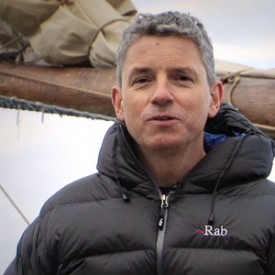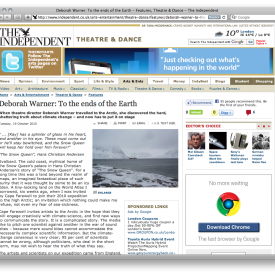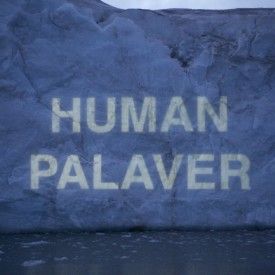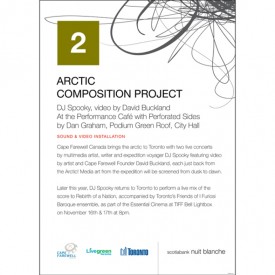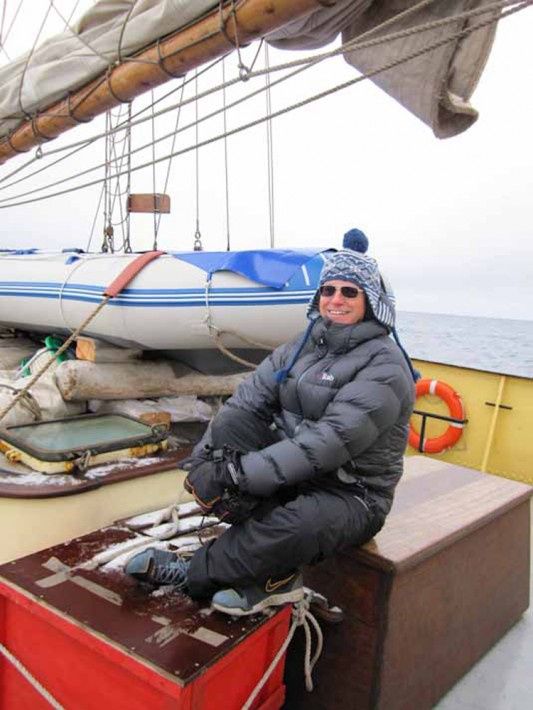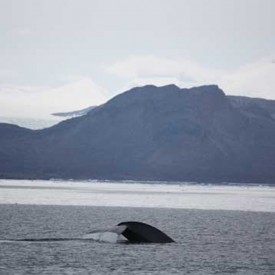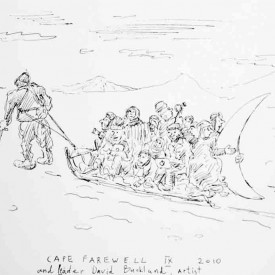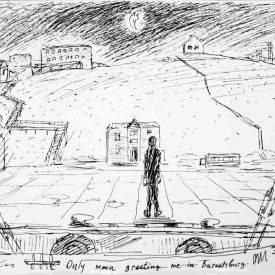I spent some of this morning slowly reading a terrific book by Francis Spufford, about the polar expeditions, gloriously subtitled ‘Ice and the English imagination’; I read the chapter about the sublime, and, among other things, the romance of catastrophe inherent in the sublime, which may have drawn Scott and co to the south pole a century ago (and certainly played a part in the reaction to their deaths).
Little did I know. After lunch, everything seemed normal. Perhaps this is always how disaster looks, before it nearly happens. Anyway, I’m getting ahead of the drama. We set off into what looked like open seas, with some pack ice far away, a tense white line on the horizon. The idea of iceberg watching holds a certain romantic allure for most of us. But as we sailed further, anticipating a northwesterly course out of the Widjefjordan passage, the ice suddenly surrounded and then crowded in on us. At first this was thrilling– we got to observe these big beasts from the theatrical circle of the deck. To our delight, and somehow amusement, one or two even held the clear footprints of polar bears. But then, very suddenly, like the calculated teeth and jaws of a bank vault, the perfect white shards and fragments simply closed ahead and behind us, and we were trapped fast in the grip of the ice.
Ted revved the engine, and we made some semi-heroic but disastrously slow progress; nevertheless the floes were now large, and densely packed; there was little sea left open to push them aside, and I believe we all suddenly felt the first odd trill of something going wrong. The ship drilled and drilled against the heavy floes, and perhaps we advanced – but only by inches.
And then everything became very still. The ship stopped moving at all. The ice was white, dense, broken and ruined and beautiful, sending peaks and shears into the air; I’ll never forget the sound of the big parts of the puzzle, knocking and jostling together, white and blue, on the black water. Then the sky darkened and the wind began its own advance on our frail bark, driving us inexorably towards the land. Shards of ice the size of cars and trucks, as sharp as window glass, were capsized and shoved under the floes by the wind alone.
We learned the bare facts of our situation. Northern sea ice had broken up, and been drawn south by currents to the east of Svalbard, and had then been driven by southern winds unexpectedly up the Widjefjordan passage – down which it should normally have been quite safe for us to pass. Usually there are daily ice maps. But today is Saturday and – to our not entirely amused astonishment – there are no updated ice-maps at the weekend. No one else is up here this far north.
Inside the cabin, our remarkable captain Ted spoke a very few words in somber tones on the satellite phone to Longyearbyen’s emergency services, giving extremely precise location details for the ship.
I went outside, and stood next to Deb. We were looking out over the battlefield of the ice, when she suddenly called out: ‘polar bear.’ And there it was, ambling casually over the ice floes at a distance of maybe 500 yards, not seeming to take much notice of us, but heading exactly in our direction. It moved with a panther’s slow grace – no hurry, total confidence, pacing from floe to floe. Its legs were taller than I’d imagined, and its eyes sensitive dark spots with wide black brows set in yellow-white fur. To our astonishment, like something walking out of a myth, it gazed at us, and passed within 50 feet of the prow. We were all warned it could leap onto the ship, and if we were ordered to move, we should not hesitate. Andrei stood ready with his flare gun and his rifle over his shoulder. But the bear seemed merely tired, and with an indiscreet yawn it settled down on a nearby flow, and rested its beautiful powerful head on its paws, like a dog before a fire. It turned out to be distracting us magnificently from an even more present danger which had now become apparent; the wind was driving us onto rocks only 300 yards or so away.
At this moment, David gathered us together, saying the emergency services were worried, more than they probably needed to be, so the Longyearbyen helicopter was coming, and we should prepare ourselves to be air lifted and evacuated back to the freezing huts of Kinnvika. We were to bring our passports and documents, and dress in all the warmest clothing we could find. This kick of adrenaline got us all moving. Sonja the heroic cook began pouring dinner into plastic containers with a calmness and forethought I found staggering. I stood in the little cabin, pulling on layers of clothing, watching myself in the mirror; I looked like a performer getting over-heated in a fat suit of all my ice-breaker purchases and technical socks, unprepared for my role in a melodrama (abandon ship!) which was suddenly, impossibly, turning out a little bit too real. Surely this wasn’t the ending we imagined or deserved? I made sure to include my partner Edward’s letters in the tiny backpack of stuff I was taking with me, and headed back on deck.
Time seemed to be moving faster than usual. As if to add to the freakishness of the moment, like a trump card up the sleeve of the Arctic, a second female polar bear with cub was spotted further away; were they converging? Did they scent a smorgasbord of climate change artists and scientists? We scanned the skies, and wondered if we should have brought our laptops, and prepared ourselves to be airlifted, like so many Peter Pans and Tinkerbells in a West End production, up into the belly of the helicopter…
But then! As if in response to the impending disaster of the situation, the ship suddenly surged ahead; the ice seemed looser, less certain, as if it had changed its mind and decided to let us go after all. The engine, freed from opposition, quickly built up a head of speed; we swatted the next floes aside with mere crunches and shudders, and then, within ten minutes, we were in the glory of wide-open water. We had escaped. The helicopter now appeared in the sky, circled us to check on our situation, and then headed back into the icy clouds, leaving us alone again.
We ate dinner with the appetite of survivors, with the relish of victors. We toasted the captain. We celebrated our happy ending. Perhaps we thought about how our brush with the sublime and its powers might remind us that we’re in a place of great danger. But then there was desert to enjoy, and more wine, and this blog to write. However, when I lie back on my bunk tonight, as we float on dark open waters, I’ll remember the menacing way the ice closed against us. It looked like a destructive urge. It looked deliberate.
BACK TO TOP